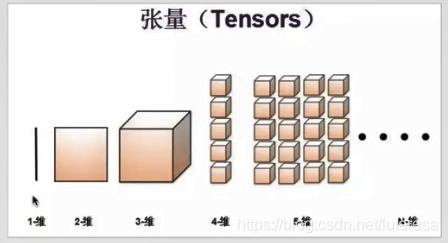TensorFlow由两部分组成,Tensor(张量) 和 Flow(流,计算图)
1.Tensor(张量)
In TensorFlow, data isn’t stored as integers, floats, or strings. These values are encapsulated in an object called a tensor.
TensorFlow使用Tensor来表示所有的数据,Tensor可以理解为N维数组或列表。

2.Session
TensorFlow’s api is built around the idea of a computational graph, a way of visualizing a mathematical process. Let’s take the TensorFlow code you ran and turn that into a graph:

A “TensorFlow Session”, as shown above, is an environment for running a graph. The session is in charge of allocating the operations to GPU(s) and/or CPU(s), including remote machines.
The code creates a session instance, sess, using tf.Session. The sess.run() function then evaluates the tensor and returns the results.
Tensor是一个张量,用于存放各种数据,多个Tensor按计算图组织数据关系,sess会话调用run()执行计算,促使Tensor按计算图流动,得到计算结果,是为Tensor Flow。
More in :
https://medium.com/tebs-lab/deep-neural-networks-as-computational-graphs-867fcaa56c9?
3.常量
import tensorflow as tf
import os
#os.environ['TF_CPP_MIN_LOG_LEVEL'] = '1' #默认显示所有信息
os.environ['TF_CPP_MIN_LOG_LEVEL'] = '2' # 只显示警告和错误
#os.environ['TF_CPP_MIN_LOG_LEVEL'] = '3' # 只显示错误
hello = tf.constant('hello')
n = tf.constant(99)
print(hello)
print(n)
print(type(hello))
Tensor(“Const_12:0”, shape=(), dtype=string)
Tensor(“Const_13:0”, shape=(), dtype=int32)
<class ‘tensorflow.python.framework.ops.Tensor’>
session = tf.Session()
print(session.run(hello))
b’hello’
print(str(session.run(hello),'utf-8'))
hello
print(session.run(n))
99
指定常量的数据类型
str_value = tf.constant('hello tensorflow!', dtype=tf.string)
print(str(session.run(str_value),'utf-8'))
hello tensorflow!
print(session.run(tf.constant(32,tf.int32)))
32
常量运算
x = tf.constant(20)
y = tf.constant(60)
session = tf.Session()
add = tf.add(x,y)
sub = tf.subtract(x,y)
mul = tf.multiply(x,y)
div = tf.divide(x,y)
print(session.run(add))
print(session.run(sub))
print(session.run(mul))
print(session.run(div))
80
-40
1200
0.3333333333333333
# x*x + x*y + 10
result = x * x + x*y +10
value = tf.constant(20)
print(session.run(result))
1610
4.占位符,Input
不指定值,可以重用tensor,必须指定类型;
Tf.placeholder: 传入普通变量,返回一个tensor,tensor用于tf.session.run()。
如果feed_dict与tensor类型不匹配且不能强制转换, you’ll get the error “ValueError: invalid literal for…”.
input1 = tf.placeholder(tf.int32)
input2 = tf.placeholder(tf.int32)
output = tf.add(input1, input2)
session = tf.Session()
# print(session.run(output)) 直接运行,出错
print(session.run(output, feed_dict={input1:2, input2:3}))
print(session.run(output, feed_dict={input1:10, input2:20}))
print(session.run(output, feed_dict={input1:[1,2,3], input2:[2,3,4]}))
5
30
[3 5 7]
5.变量
x = tf.Variable(2)
y = tf.Variable(3)
f = x*x + y +3
session = tf.Session()
session.run(x.initializer) # 必须调用run, 初始化变量
session.run(y.initializer)
session.run(y)
3
session.run(f)
10
x.load(10,session)
y.load(20,session)
session.run(y)
20
session.run(f)
123
session.close()
with tf.Session() as session:
y.initializer.run()
x.initializer.run()
r = f.eval() #
print(r)
10
并不会一下子初始化,而是在计算图中创建一个节点,这个节点会在绘画执行时初始化所有变量;惰性初始化
一个TensorFlow程序分为两部分:
1.用于构建计算图的部分;
2.用于执行计算图部分;
我们的主要工作是构建计算图。
init = tf.global_variables_initializer()
with tf.Session() as sess:
init.run()
ret = f.eval() #执行计算图
print(ret)
10
6.TensorFlow运算函数
官网API: https://www.tensorflow.org/api_docs/python/tf/math
import tensorflow as tf
import os
#os.environ['TF_CPP_MIN_LOG_LEVEL'] = '1' #默认显示所有信息
os.environ['TF_CPP_MIN_LOG_LEVEL'] = '2' # 只显示警告和错误
#os.environ['TF_CPP_MIN_LOG_LEVEL'] = '3' # 只显示错误
x = tf.Variable(10)
y = tf.Variable(20)
z = tf.Variable(-5)
value = tf.Variable(2.5,dtype=tf.float32)
init = tf.global_variables_initializer()
with tf.Session() as session:
init.run()
print(session.run(tf.add(x,y)))
print(session.run(tf.subtract(x,y)))
print(session.run(tf.multiply(x,y)))
print(session.run(tf.divide(x,y)))
print(session.run(tf.mod(x,y)))
print(session.run(tf.abs(x)))
print(session.run(tf.negative(x)))
print(session.run(tf.square(x)))
print(session.run(tf.sqrt(value))) #不能是整数
print(session.run(tf.sign(z)))
print(session.run(tf.sin(value))) #float
30
-10
200
0.5
10
10
-10
100
1.5811388
-1
0.5984721
类型转换
tf.subtract(tf.constant(2.0),tf.constant(1)) # Fails with ValueError: Tensor conversion requested dtype float32 for Tensor with dtype int32:
保持表达式类型一致,或强制转换
tf.subtract(tf.cast(tf.constant(2.0), tf.int32), tf.constant(1)) # 1
7.管理计算图
import tensorflow as tf
import os
#os.environ['TF_CPP_MIN_LOG_LEVEL'] = '1' #默认显示所有信息
os.environ['TF_CPP_MIN_LOG_LEVEL'] = '2' # 只显示警告和错误
#os.environ['TF_CPP_MIN_LOG_LEVEL'] = '3' # 只显示错误
sess = tf.Session()
x1 = tf.Variable(5, name='x1')
sess.run(x1.initializer)
print(tf.get_default_graph().get_operation_by_name('x1'))
print(tf.get_default_graph().get_operation_by_name('x1').get_attr('dtype'))
print(x1.graph is tf.get_default_graph())
#创建一个新计算图
graph = tf.Graph()
with graph.as_default():
x2 = tf.Variable(20)
print(x2.graph is graph)
print(x2.graph is tf.get_default_graph())
name: “x1”
op: “VariableV2”
attr {
key: “container”
value {
s: “”
}
}
attr {
key: “dtype”
value {
type: DT_INT32
}
}
attr {
key: “shape”
value {
shape {
}
}
}
attr {
key: “shared_name”
value {
s: “”
}
}
<dtype: ‘int32’>
True
True
False
8.计算图节点的依赖与生命周期
import tensorflow as tf
import os
#os.environ['TF_CPP_MIN_LOG_LEVEL'] = '1' #默认显示所有信息
os.environ['TF_CPP_MIN_LOG_LEVEL'] = '2' # 只显示警告和错误
#os.environ['TF_CPP_MIN_LOG_LEVEL'] = '3' # 只显示错误
k = tf.constant(333)
x = k + 1
y = k + 2
z = x + 5
# 依赖重复计算两次
with tf.Session() as sess:
print(y.eval())
print(z.eval())
#依赖只计算一次
with tf.Session() as sess:
y_val, z_val = sess.run([y,z])
print(y_val, z_val)
#在计算图每次执行时,所有节点都会被丢弃,但变量不会,变量是由Session维护,除非关闭Session,否则变量一直存在
335
339
335 339
